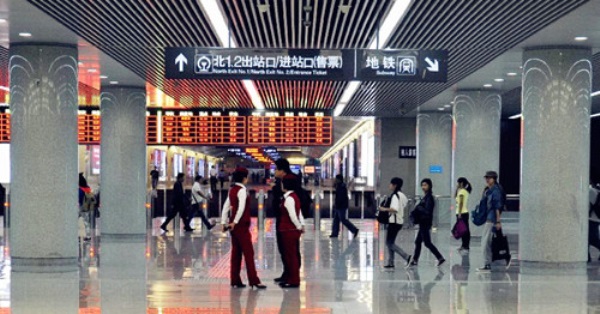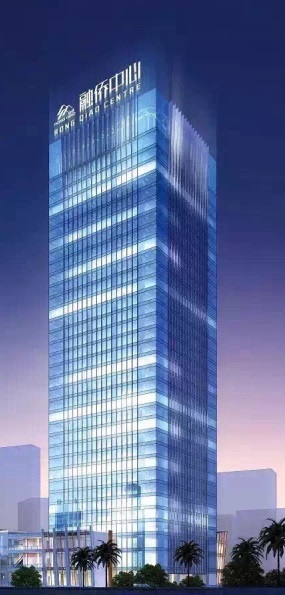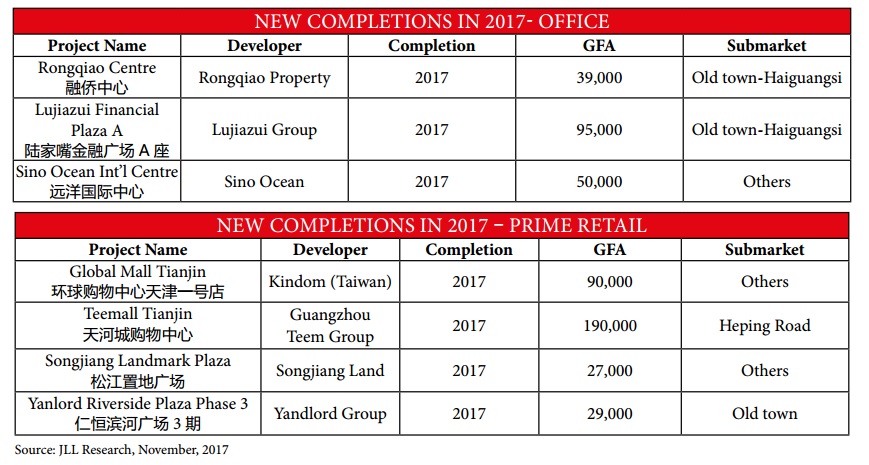Central Tianjin Commercial Real Estate Market 2017 Review
By Michael Hart, Managing Director at JLL Tianjin and Chelsea Cai, Head of Research at JLL Tianjin
 回望2017年度,天津的地产结构发生了巨大变化。今年9月,天津作为全运会的主办城市,吸引了来自全国甚至全球各地的很多游客和运动员来到天津,天津地区的酒店入住率和销售收益都非常可观,与此同时,政府大规模投资修建的公路、铁路和地铁等交通设施也大大方便了各区之间人们的生活和交通便利。在高级写字楼方面,天津已经新建了一批现代化写字楼,它们在带给大家更为高效的办公空间的同时,也取代了质量较差的传统写字楼,吸引了更多企业入驻。这些写字楼不仅改变着公司格局,工作环境,甚至影响着城市的天际线。值得注意的是,在地铁站附近的写字楼明显占据更大的便利优势,随着夏季与冬季极端天气的增加以及人们对交通便利的依赖程度,地铁沿线尤其是换乘站周围的写字楼受到更多企业的青睐。
回望2017年度,天津的地产结构发生了巨大变化。今年9月,天津作为全运会的主办城市,吸引了来自全国甚至全球各地的很多游客和运动员来到天津,天津地区的酒店入住率和销售收益都非常可观,与此同时,政府大规模投资修建的公路、铁路和地铁等交通设施也大大方便了各区之间人们的生活和交通便利。在高级写字楼方面,天津已经新建了一批现代化写字楼,它们在带给大家更为高效的办公空间的同时,也取代了质量较差的传统写字楼,吸引了更多企业入驻。这些写字楼不仅改变着公司格局,工作环境,甚至影响着城市的天际线。值得注意的是,在地铁站附近的写字楼明显占据更大的便利优势,随着夏季与冬季极端天气的增加以及人们对交通便利的依赖程度,地铁沿线尤其是换乘站周围的写字楼受到更多企业的青睐。
天津的零售业房地产市场在2011年、2012年前后以及2015年前后迎来了两次高峰,2011年南开大悦城开幕,2012年银河国际购物中心开幕,这两家商场为大家带来了非凡的别样体验,甚至在商场内建成了溜冰场。而在2015年左右开设的商场,主要功能是方便居民日常购物的需求,开设的地理位置也相较分散在各区域居民方便到达的区域中心。随着网上购物的普及以及电商市场的扩大,线下购物中心将把更多的空间用于餐饮和娱乐消费,同时会引进新奇的体验概念来吸引消费者。商场的空间也不仅仅只是用于销售,例如某些商场的中庭区域已经变为了展览展示和活动的举办地。
在酒店地产方面,过去十年天津的星级酒店一直在持续增加,2017年更是有两家新的星级酒店入驻天津。位于和平区的四季酒店和位于红桥区的万怡酒店于本年度隆重开业,受惠于中国的小长假以及本地居民消费水平的提升,酒店业的发展情况也依然看好。酒店也不再仅仅是提供住宿的场所,其自助餐、主题餐饮等更是受到了广大本地居民的欢迎。
除上述变化外,天津房地产的投资热度也依然在升温。虽然各建筑工地受到冬季停工限制的影响,我们仍然可以期待2018年将有多个新项目竣工。这些新的写字楼、商务用地以及零售商场都将给天津人带来新的生活体验。总体来看,2017年是发展迅速、变化巨大的一年,新项目和新建筑不仅影响了人们的工作生活方式,更推动了城市发展的进程。相信2018年的天津地产业也将发展得越来越好。
While Tianjin was in the national press in 2017 as the host of China’s National Games, it continued to witness significant activity in the commercial real estate market as well. For the games in September, the seaport city attracted many athletes and tourists and saw hotel occupancies and retail sales benefit as a result. However, also seeing more activity were the new roads, rails, and metro links that resulted from large government investments several years ago and which have now expanded the distance for easy daily commuting across the city. Continued investment in the commercial real estate market has also continued to reshape central Tianjin’s skylines and has even changed how people interact within the city’s six central districts of Hebei, Hedong, Heping, Hexi, Hongqiao, Nankai. In this article, we take a closer look at how the city has changed from a real estate perspective in 2017.
The Evolving Office Market Landscape
A new wave of office buildings constructed in Tianjin has helped to highlight three major trends. First, the new buildings are drawing many tenants into more modern and efficient office space, replacing poorer quality office stock. With rents near record low, we expect this trend to continue. Second, these new office buildings are helping new commercial areas to establish themselves in the city. Finally, office buildings, often located near subway stations have changed the way many Tianjin residents get around the city.
 Ten years ago, office workers usually commuted via bus, bicycle, and cars. However, in the first half of 2017, the average daily passenger volumes on the subway system reached 950,000 with an annual estimated passenger volume reaching 340 million. With crowded roads, license plate restrictions, increasing parking fees, hot summers and cold winters we do not expect this trend to reverse. In fact, for office buildings and shopping malls, having a subway station is now a key amenity.
Ten years ago, office workers usually commuted via bus, bicycle, and cars. However, in the first half of 2017, the average daily passenger volumes on the subway system reached 950,000 with an annual estimated passenger volume reaching 340 million. With crowded roads, license plate restrictions, increasing parking fees, hot summers and cold winters we do not expect this trend to reverse. In fact, for office buildings and shopping malls, having a subway station is now a key amenity.
A review of the new or soon to be completed office buildings helps to highlight new commercial areas that are emerging. These include the Lujiazui project located in Hongqiao district and several new buildings in the New Badali area located in Hexi district. Although not fully built out, future subway lines will help determine which office projects are long term winners because those buildings will immediately be well connected to a system that cuts down on commute times and links these buildings to Tianjin’s various train stations and airports. For example, the Meijiang area which is often thought of as being on the edge of central Tianjin, will, once subway line 6 is extended, be more easily accessible than some office buildings in Heping and Hexi districts because it will have a host of new subway stations.
 Mall Experience Challenges and Interesting Trends
Mall Experience Challenges and Interesting Trends
The Tianjin retail market has experienced two supply peaks so far in the 2000s, the first was in 2011 when “experience” shopping malls, such as Joy City Nankai and Galaxy International shopping centre (2012) and brought anchors such as ice-rinks, cinemas and spas into malls to attract customers and convince them to stay the whole day. The second peak happened with several large-size (usually larger than 50,000 sqm in GFA) malls making a foray into the suburban areas around 2015 or later. These included Aegean mall (250,000 sqm) in Hedong district, which opened in 2015, and three more which opened in 2016 including Incity (60,000 sqm) in Xiqing district, SM Phase 1 (70,000 sqm) near the airport and Delight City (200,000 sqm) in Nankai district. Many of these are community malls focused on catering to residents’ daily shopping preference or weekend family activities.
As much of the shopping is being done online, malls are dedicating more spaces to restaurants and novel F&B concepts to lure shoppers in. This year newly opened malls have had to mix up their tenants and food has been an important backup option. For example, newly opened Joy City Heping scrapped an underperforming cosmetics anchored basement tenant mix and replaced it with a food hall concept. Instead of only going for standard chain stores, malls are starting to bring in stores that have never had the presence in malls before, but have an established local reputation as street shops or stands. At its heart, the food hall concept provides a concentrated experience making them more accessible to nearby office workers and yet still appealing to foodies and today’s fickle consumers.
We are also starting to see malls add in lifestyle experiences such as events, exhibitions, and pop-up stores in their atriums and common areas. The goal is to provide consumers a new experience on each visit, to keep them coming back.
 New Hotels Presence in Tianjin
New Hotels Presence in Tianjin
While the past decade has seen a significant increase in five-star hotels in Tianjin, two more were added to the list in 2017. The Four Seasons located in Heping district and the Courtyard by Marriot located in Hongqiao district both opened to bring additional amenities to their respective areas. Overall, the hotel market benefited from national events and short-term holidays. The average market occupancy rate rose by 7.1% y-o-y to 55.4% by September 2017, during the National Games and short-term holidays. The hotels didn’t only cater to visitors. Restaurants located in the city’s hotels continue to be popular with local residents, especially the weekend buffets and during events around holidays.
Investment Market Heating Up
In 2017, an increasing number of investors entered the local property investment market. Several properties that sold include the Somerset serviced apartment located in Youyi Road, which was sold to a domestic developer, Tahoe Group. Tai’an Dao No. 5 office building, located in the Xiaobailou area, was recently sold to China Life Insurance from the government-backed developer, Tianjin Real Estate Development Group. Additionally, Tompson Jinwan, an office building currently under construction across the river from the train station, was purchased by a Zhengjiang finance company. Although not sold outright, the Galaxy International Mall recently received a large investment from the China Resources Group and we believe this will lead to some major changes in the mall’s operations.
What to Expect In 2018
A recent announcement that for environmental reasons there would be a six-month ban on construction during the winter has raised questions about completion schedules for a number of projects. Despite that we still expect a number of new projects to completed in 2018. A fresh wave of office projects including Luneng International Centre and the China Overseas office building, both located near the Tianjin TV tower are anticipated to open in 2018. We also expect to see Shuangying Plaza developed by Bohai Real Estate Development Group, to be the first office project to be completed in the New Badali area located along Heiniucheng Road. In addition, shopping centres, Luneng CC plaza and Lujiazui’s L+ Mall are expecting to open before 3Q18 and provide new retail brands and experiences for shoppers.
In summary, 2017 has been an active year with new projects completed in the market and new infrastructure redefining where people choose to work and shop. In 2018, yet more new commercial real estate projects will be completed, thus continuing this trend and raising the bar for existing landlords. In addition to new projects, a few new investors and retail concepts will help the market continue to evolve and with the summer World Economic Forum event slated for Tianjin again in 2018, the hotel market should see at least one positive bump as well.
 ---END---
---END---